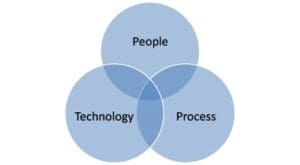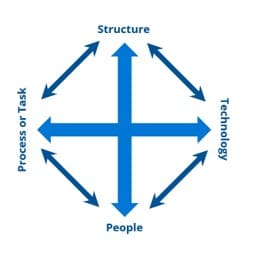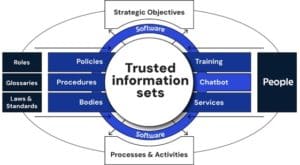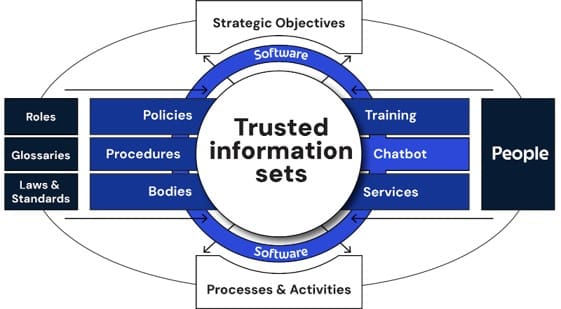The InfoSystem Model Canvas (IMC) can be significantly described as a recent evolution of the triptych People Process Technology (PPT) and of the Leavitt diamond (People, Process, Technology, Organisation). It builds on these fundamental models by providing a more granular, information-centric perspective specifically tailored to the field of information governance.

The PPT model, a long-standing framework in computing and business, highlights the three fundamental components of any system. Leavitt’s Diamond extended this by explicitly including the organisation as a fourth crucial element, recognising the structural and contextual factors that influence the effectiveness of the system.

The IMC encompasses and expands on these concepts, providing a richer and more detailed understanding of the interconnected elements within an infoSystem, which Exquando defines as a “dynamic system composed of information in all its forms, hardware, software, rules of all kinds, but also humans and their environment, all acting in interaction and as a functional unit“.

Here’s how the IMC can be considered an evolution:
- People: the PPT models and Leavitt’s diamond include People, and the IMC also has People as a key component. However, the IMC breaks this element down further by explicitly including the Roles (InfoRole) and the concept of InfoPlayers, highlighting the specific responsibilities and actors involved in information management. This provides a more nuanced understanding of the human element in the context of information governance.
- Processes: processes are at the heart of the two previous models and are also represented in the IMC by the Processes (InfoProcess) and procedures. The IMC’s focus on information governance, however, encourages a more in-depth consideration of processes specifically related to the creation, storage, processing and destruction of information.
- Technology: The Technology in the PPT model and the Leavitt diamond corresponds to the Software (InfoTool) in IMC. IMC recognises the importance of tools, but places them in a broader context of information management, where technology is a means of governing Trusted Information Sets.
- Organisation:The Leavitt Diamond explicitly includes the Organisation. The IMC addresses this through the Committees (InfoBodies), such as the Steering Committee, who are responsible for the direction and governance of the infoSystem. The IMC also integrates the Policies (InfoPolicy) and the Rules (InfoRule), as well as the infoConstitution, which collectively define the organisational framework for information management. The inclusion of Strategic Objectives further anchors the infoSystem in the overall objectives of the organisation.
- Information-Centricity: A significant advance of the IMC is its explicit focus on the information itself as a central element, represented by the Trusted Information Sets. This goes beyond the implicit manipulation, by the previous models, of data Technology and Processes, positioning information as a primary asset to be governed. The definition of Trusted infoSet – InfoProduct as governed information resulting from agreed acquisition and processing processes underlines this central orientation.
- Governance Specificity: The IMC integrates elements directly relevant to information governance, such as Glossaries (InfoVoc) to establish a common understanding, the Training (InfoCourse, InfoTrainings) to develop the necessary skills, and the Information Services.These components reflect the specific needs and activities involved in effective information governance. The emphasis on establishing the confidence within the steering team and the clear definition of the responsibility (Empowerment, ownership) are also key aspects highlighted by the IMC in the context of information governance.
In essence, while the PPT model and Leavitt’s diamond provide valuable high-level frameworks for understanding systems, the IMC offers a more detailed and contextually rich model, specifically designed to navigate the complexities of information governance. It retains the fundamental elements of people, processes, and technology, integrates the crucial organisational dimension, and, most importantly, emphasises the information itself and the specific mechanisms of its governance in the foreground.
Therefore, the InfoSystem Model Canvas can actually be considered a recent and more specialised development, adapted to the challenges and opportunities of information management in today’s organisations.





